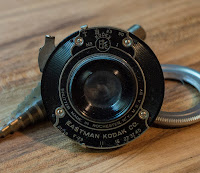Now that was a fun project! Taking the lens from a 91 year old folding camera, and mount it on a new digital camera to see how good these old lenses really were. And looking awesome wile taking the pictures! I had a lot of other camera-guys give me a second look when parading this concoction on the street. Pretty cool!
The Kodar 131mm lens is an achromatic meniscus lens with a maximum aperture of f/6.3 and a Kodex 1 shutter with four speeds: time, bulb, 1/25, and 1/50. In my case, I could use the T setting (shutter stays open in the level is pressed again), so I could use the electronic shutter of the Sony. The bellows make for smooth focussing. So smooth that I wonder why this is not used more often... I will for sure use the bellows again with some other lenses.
Of course, you can not expect the same quality as today's lenses, but I was pleasantly surprised. A little bit of focus smear when pixel peaking, but little color fringing. As there is no lens coating, taking pictures in the direction of the sun is out of the question. Sharpness was not that bad, for a lens this old. I did like the awesome bokeh this lens produced, as proven by the flower pictures below.
Of course, I did have to figure out how to mount this lens on the Sony camera. Looking bad, once I had the right tools (the Pentax bellows, a metal M42 camera body cap and a step drill bit - from eBay), it was fairly easy to do.
 |
| Removal of the camera system from the main body, for easy access to the lens. |
 |
| Removal of the lens and shutter unit by using a lens spanner. |
 |
| Use a stepped drill bit to make a hole in the metal body cap, the size of the screw mount of the shutter system. |
 |
| Use the adapter ring of the original camera to mount the shutter system on the body cap. and screw it on the bellow. Done! |
Lens Specification:
Focal Length: 131
Maximum Aperture: F6.3
Minimum Aperture: F45
Image Format: 116
Lens Mount: Screw Mount
Optics: 3 elements
Blades: 9
Focussing: Manual via Bellows
Minimum Focus: ??cm
Filter Size: na
Weight: na
Length: na
Production: 1926
Serial Number: na
Made In: USA
Although it was not a high end camera at the end, it's nicely art-deco decorated, and looks awesome of the shelf. I haven't tried but expect the camera is full working order. No worries, nothing got damaged during this test!
Kodak's economical group of achromatic lenses
It should be noted that in the 1920s and early 1930s, the Kodar was usually a triplet design of decent performance. In later years it was often a doublet design of lesser quality. This name has been used for various lenses until the present time.
Adapter: Honeywell Pentax Bellows II - M42
Cost: can't remember :-) - on eBay
What can I say, it's a bellows adapter. Well made, smooth focussing. good markings. There is only one minor issue when mounting on the Sony camera with an adapter ring. It's impossible to just mount the whole bellow on the camera, as the rail system, when being mounted, is blocked by the camera body. Luckily, you can take the mount piece itself from the bellow, mount it separately on the camera, and slide the bellows back on. Easy to do...
Samples:
Sources:
CameraPedia - Kodak Lenses
Vintage Camera Lab
Mike Ecman Dot Com
Samples:
 |
| 1/125s - ISO400 - Handheld |
 |
| 1/80s - ISO800 - Handheld |
 |
| 1/200s - ISO800 - Handheld |
 |
| 1/160s - ISO800 - Handheld |
 |
| 1/320s - ISO800 - Handheld |
 |
| 1/125s - ISO800 - Handheld |
 |
| 1/125s - ISO800 - Handheld |
 |
| 1/500s - ISO100 - Handheld |
 |
| 1/200s - ISO100 - Handheld - Cropped |
 |
| 1/500s - ISO100 - Handheld |
 |
| 1/400s - ISO100 - Handheld |
 |
| 1/125s - ISO400 - Handheld |
 |
| 1/50s - ISO100 - Handheld |
Sources:
CameraPedia - Kodak Lenses
Vintage Camera Lab
Mike Ecman Dot Com





No comments:
Post a Comment